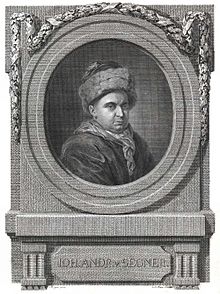Johann Andreas Segner facts for kids
Quick facts for kids
Johann Andreas Segner
|
|
|---|---|

Johann Andreas Segner's portrait
|
|
| Born | 9 October 1704 |
| Died | 5 October 1777 (aged 72) |
| Nationality | Hungarian |
| Citizenship | Kingdom of Hungary |
| Known for | Segner wheel |
| Scientific career | |
| Fields | Mathematics |
| Institutions | Jena Göttingen Halle |
| Doctoral advisor | Georg Erhard Hamberger Simon Paul Hilscher |
| Doctoral students | Johann Georg Büsch |
Johann Andreas von Segner (born October 9, 1704 – died October 5, 1777) was an important Hungarian scientist. He was born in Pozsony, which was then the capital city of the Kingdom of Hungary. Today, this city is known as Bratislava in Slovakia. Segner is best known for inventing the Segner wheel, which was a very early type of water turbine.
Contents
Early Life and Education
Johann Segner was born to Johann Michael von Segner and Christine von Segner. His father worked as a tax clerk. Segner's family had been granted nobility in 1596 for their bravery in the military.
He studied in several cities, including Pressburg, Győr, and Debrecen. In April 1725, Segner began his studies at the University of Jena in Germany.
Discoveries in Jena
At the University of Jena, Segner worked with his teacher, Georg Erhard Hamberger. Together, they found a way to prove Descartes' rule of signs. This rule helps mathematicians understand the roots of equations.
Segner was a very bright student. By his third year at Jena, he was already teaching mathematics to other students. In October 1729, he earned a degree in medicine.
Becoming a Professor
After getting his medical degree, Segner worked as a doctor in Pressburg and Debrecen for a short time. However, he soon returned to the University of Jena. In 1732, he earned another degree, this time in philosophy.
He started giving lectures in 1733. Later that year, he became a professor of philosophy. He taught about the ideas of Christian Wolff, a famous philosopher.
Working at Göttingen University
In 1735, Segner moved to the University of Göttingen. This university was quite new, having been started in 1732. He became a professor of both mathematics and physics there.
When the medicine professor at Göttingen passed away in 1736, Segner also began teaching medicine. This shows how skilled he was in many different fields of science.
Moving to Halle University
After the famous philosopher Christian Wolff died, the King of Prussia, Friedrich II, asked mathematician Leonhard Euler for advice. The King wanted to know who should take Wolff's place at the University of Halle.
Euler first suggested another scientist, but they did not accept the offer. Then, Euler suggested Johann Andreas von Segner. Segner agreed to join the University of Halle in 1755. He became a professor there, teaching both mathematics and physics.
Establishing an Observatory
While at Halle, Segner also created an observatory. An observatory is a special place with telescopes used to study stars and planets. This shows his interest in astronomy, the study of space. Segner continued his important work at Halle until he passed away on October 5, 1777.
Important Connections
Johann Andreas von Segner was a very well-known scientist during his time. He was a member of several important science groups, including:
- The Prussian Academy of Sciences in Berlin
- The Royal Society in London
- The Russian Academy of Sciences in Saint Petersburg
He also had many students who went on to become successful scientists themselves. It is estimated that he has tens of thousands of "academic descendants" – meaning students of his students, and so on.
Key Contributions to Science
Segner made several important contributions that are still remembered today:
The Segner Wheel
He was the first scientist to understand and use the power of water's "reactive force." This led him to build the very first water-jet machine, which is now called the Segner wheel. This invention looks a lot like the modern lawn sprinklers we use today.
Father of the Water Turbine
Because of his work with the Segner wheel, many historians of science consider him the "father of the water turbine." Water turbines are machines that use the force of moving water to create energy, like in hydroelectric power plants.
Other Recognitions
- The lunar crater Segner on the Moon is named after him.
- An asteroid, 28878 Segner, also carries his name.
Personal Life
In 1732, Johann Segner married Carolina Sophia. She was the daughter of Hermann Friedrich Teichmeier, who had supported Segner during his studies in Jena. Johann and Carolina had three children together, and two of them lived to adulthood.
Works in Modern Edition
- Johann Andreas Segner, Specimen logicae universaliter demonstratae (1740) edited with an introduction by Mirella Capozzi, Bologna: CLUEB, 1990.

